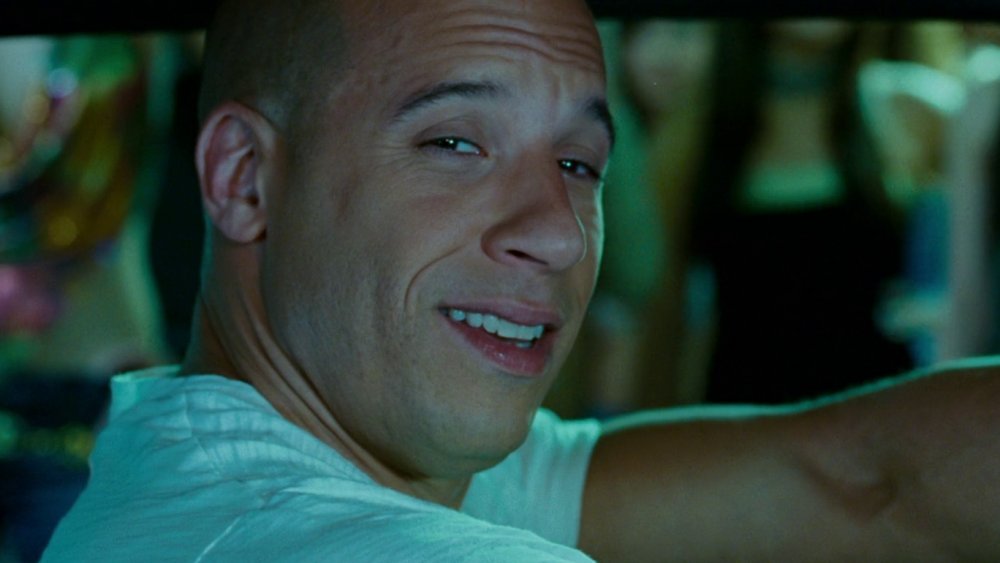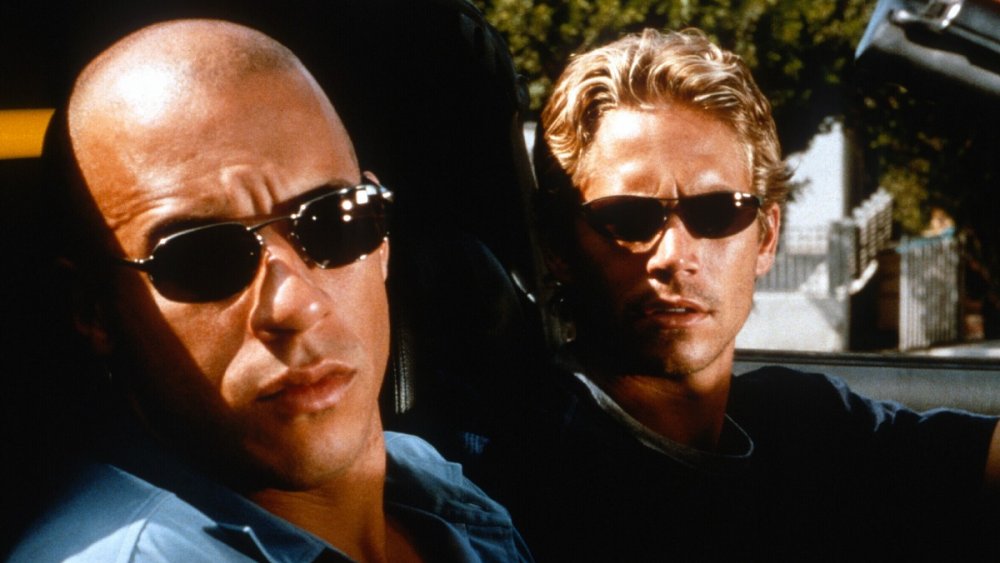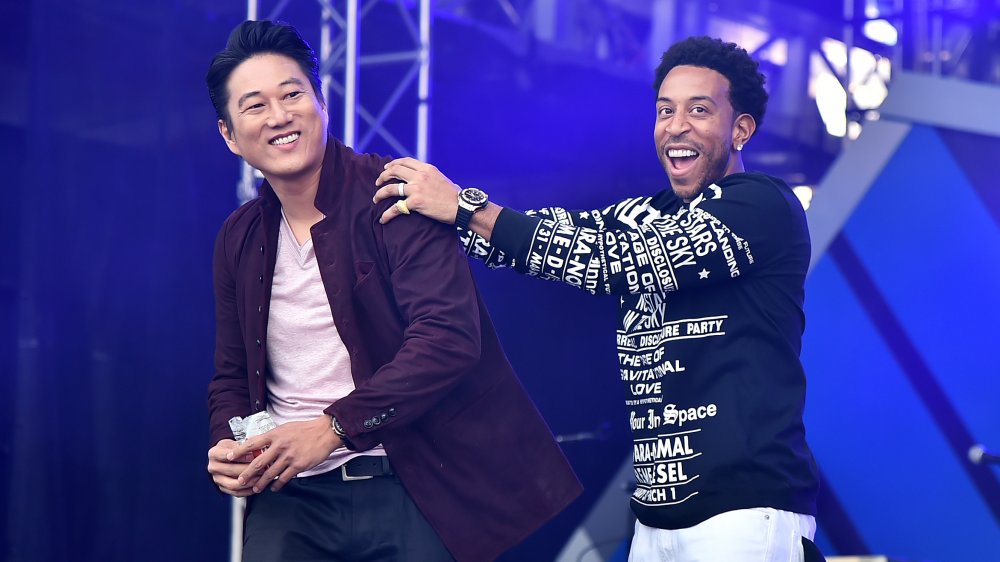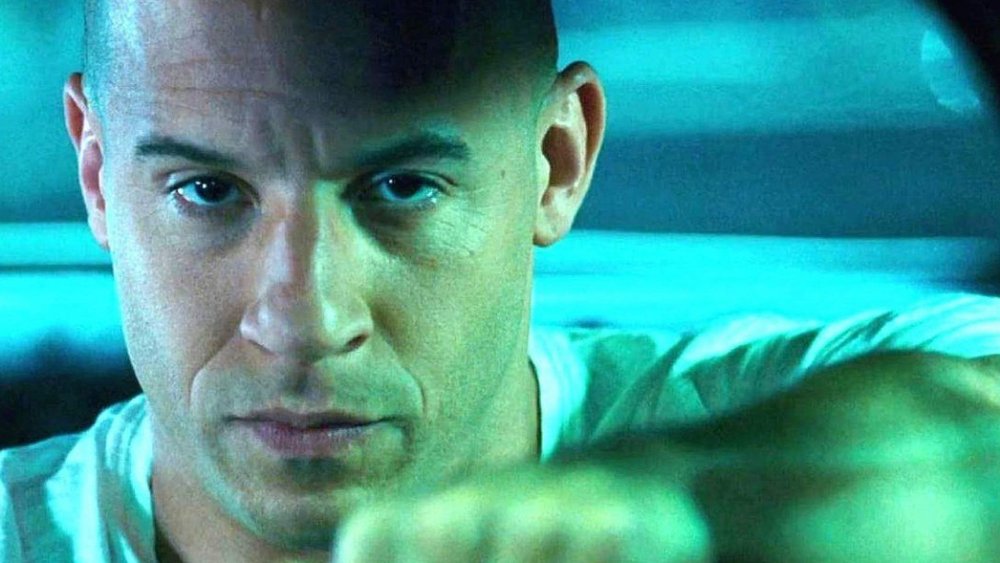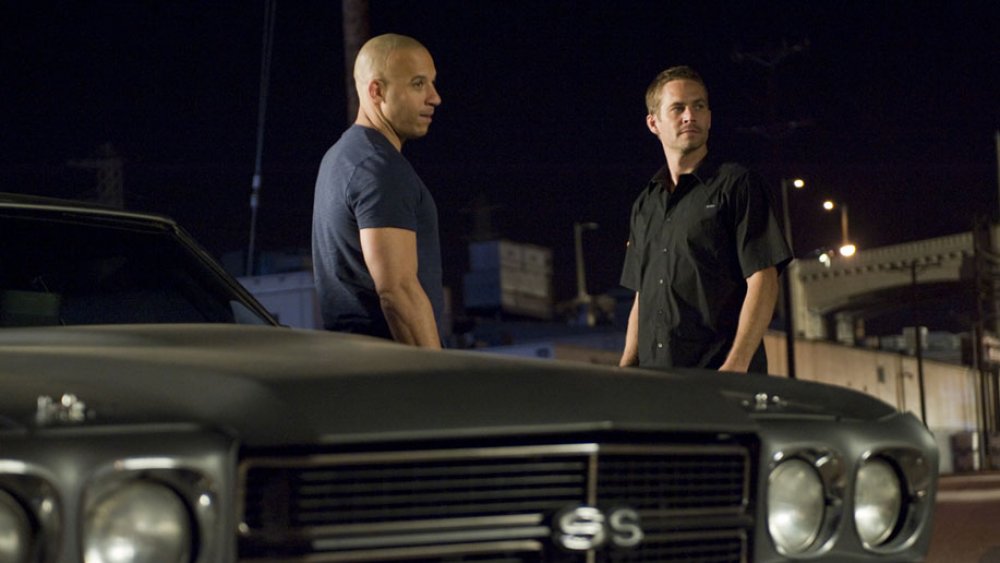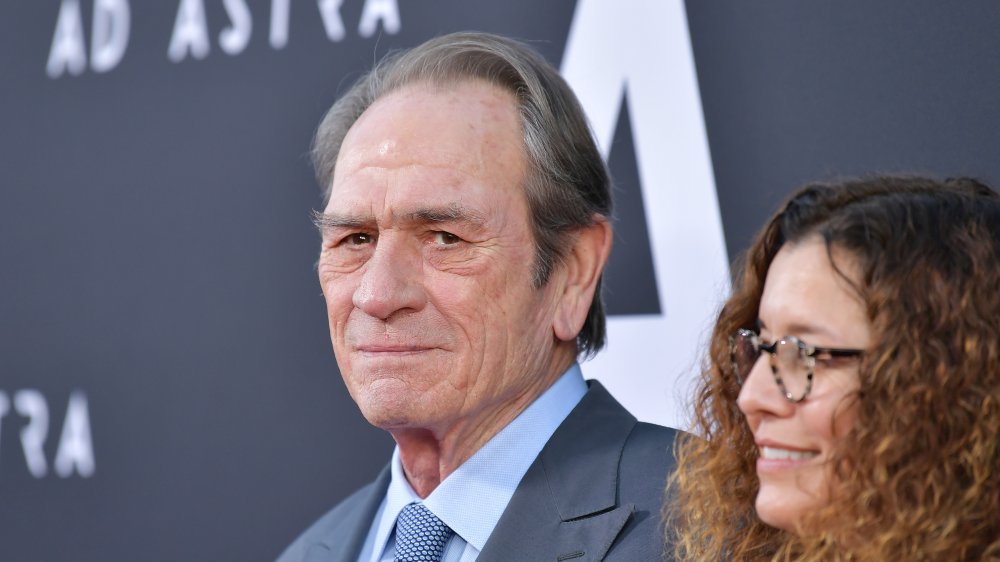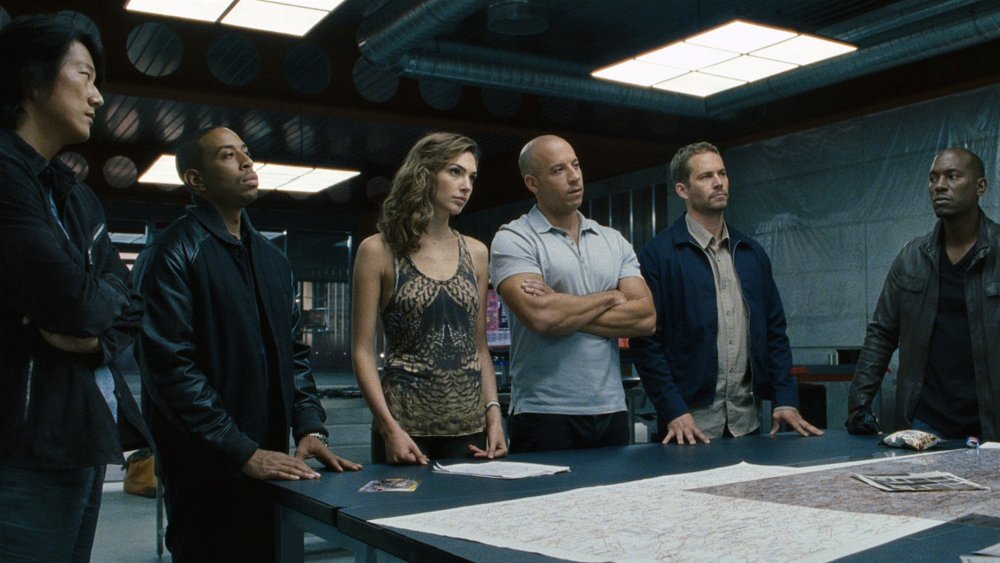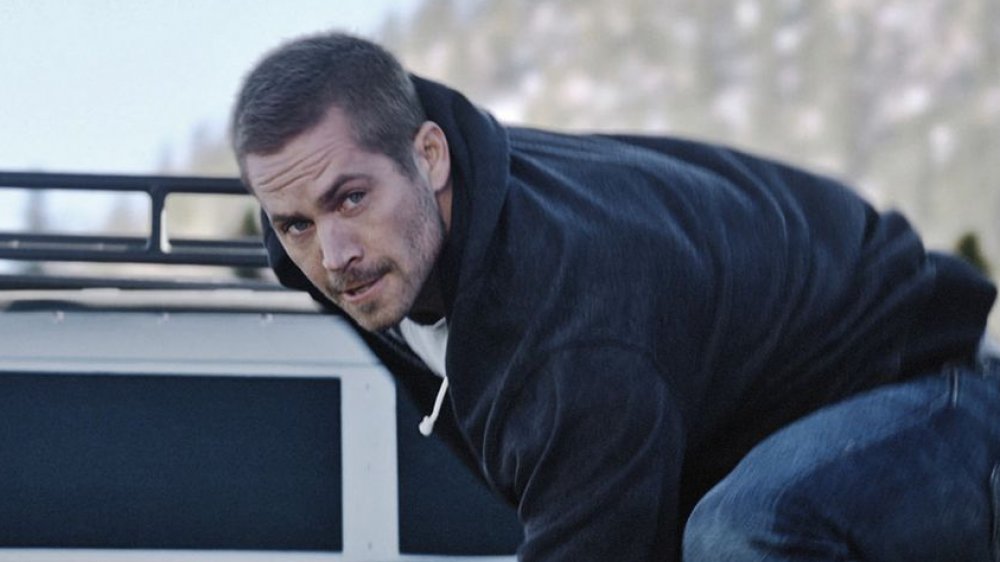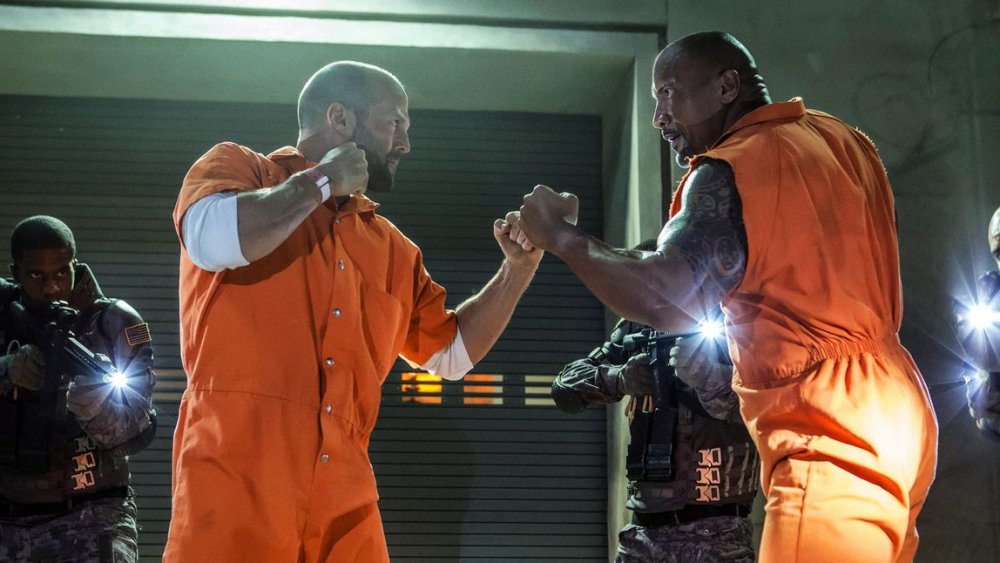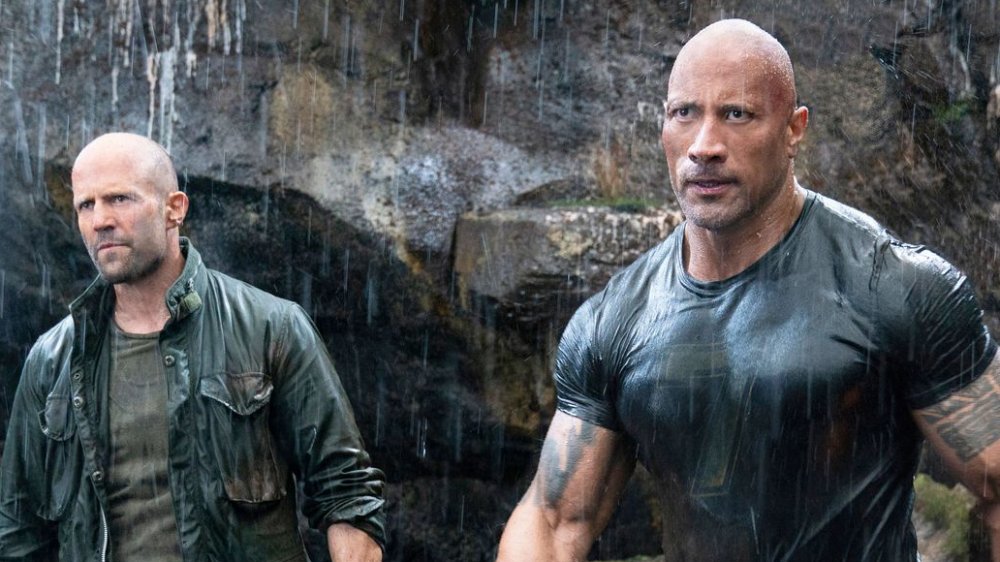Alternate Fast And Furious Movie Endings You Haven't Seen
You wouldn't think a movie about car racers turned de facto superheroes would feature a knotty and dense timeline that could rival the most sprawling sci-fi epics, but that's exactly what the Fast Saga offers. Detractors will likely scoff at the idea that the continuity of a franchise based on the flimsy foundation of a magazine article on New York City drag racers can require some serious untangling. When you live your life a quarter-mile at a time, however, you open up the possibility for countless alternate timelines.
Every race is an opportunity for something to go differently. Frequently, in the Fast world, what made it to the screen wasn't the only possible outcome. The blockbuster franchise is littered with near losses and rewritten scripts due to fan reaction, Hollywood squabbling, and unpredictable tragedy.
In short, the ten movies (and counting) of the Fast & Furious franchise have plenty of detours and alternate exits littered throughout the trivia sections of IMDb and the deep recesses of DVD box set menus. The family we will see on screen for Fast 9 almost wasn't, and the fact that it's managed to hold together under the many stresses of the ultra-successful film series is almost miraculous.
The Fast and the Furious almost kicked off the series differently
Things could have gone differently from the very beginning. While the finale setpiece of 2001's original The Fast and the Furious almost seems quaint when held up against later stunts like their Rio de Janeiro-destroying safe heist, a showdown with a nuclear submarine, and the infamous eternal runway scene, the climatic train-beating race between Vin Diesel's Dom Toretto and Paul Walker's Brian O'Connor set the tone for the rest of the wildly successful series.
In one death-defying moment, Brian and Dom learn to see each other as equals. And that leads directly to the ambiguous ending where Brian seemingly gives up his life as a LAPD detective and helps Dom escape. While the movie as released left things vague, an alternate ending released on later DVD editions would have solidified Brian's ties to the Toretto family.
In the ending dubbed "More Than Furious," Brian is shown resigning from the LAPD and tracking down Dominic's sister Mia. She is reluctant to let him back in her life, leading Brian to reveal casually that he's quit his job and has the time to work on winning her back.
2 Fast 2 Furious needed some major rewrites
2 Fast 2 Furious was the first wobble on the Fast Saga's axis, with many actors departing the series and all the requisite rewrites that would require. The sequel marked the end of Ja Rule's time in the series and lead directly to Ludacris' established role as Tej in the core group.
After Vin Diesel walked away from the movie, the team behind the sequel scrambled to rewrite it. They bumped up Ja Rule's character of Edwin, giving him a starring role in the film. Director John Singleton revealed that Ja Rule balked at his $500,000 offer for the role, leaving the movie open to become the buddy comedy between Paul Walker and Tyrese that we know today.
"Ja got too big for himself. He turned it down. He turned down a half a million dollars," Singleton told Grantland. "He got 15 grand to be in the first movie. He was really big at that time. I guess Murder Inc. was throwing out hits and were making money hand over foot. He was acting like he was too big to be in the sequel. He wouldn't return calls."
Singleton went on to share that it was his decision to reach out to Ludacris with an opportunity to join the franchise.
"I called Ludacris. I said, 'Hey, Luda, I haven't met you before, but I like what you're doing right now,'" the director recalled. "I said, 'I'm doing this movie and I'm wondering if you want to be a part of it.' He goes, 'What? Yeah! Anything you do I want to be a part of.' That's how Ludacris got in 2 Fast 2 Furious, and the rest is history."
The Fast and the Furious: Tokyo Drift just barely brought the franchise back from the brink
The tremors in the series nearly threw it off the rails as Universal eyed its third installment. Diesel was once again out and other stars followed him. Considering the franchise to be dead in the water, Universal prepared to release a straight-to-DVD sequel with none of the cast that had made the series a hit. All that changed thanks to the big ideas of screenwriter Chris Morgan.
The writer (who would go on to pen five more movies in the franchise) got his start by being incredibly enthusiastic over a movie many thought was a lost cause. In an interview with Business Insider, he explained how he pitched a movie that would bring back all of the Fast gang.
"My pitch was bring back the crew," Morgan said. "Dominic Toretto heard that someone he loves got killed in Japan and now he had to learn a new style of racing — drifting — and gain the trust of the racers to figure out what happened to his friend."
This, of course, didn't happen. But the bigwigs at Universal were impressed enough with Morgan's vision to bump up the budget and release the film theatrically. And a small part of his vision did come true — Diesel appeared in the final scene of the movie to challenge its protagonist to a race, bridging the gap in the series in exchange for the rights to his sci-fi franchise The Chronicles of Riddick.
Some short films bridged the gaps in the Fast timeline
There are several short films papering over the gaps caused by the series' tumultuous early years. If you've only ever encountered the Fast movies in theaters, you might not know that there's plenty of auxiliary material to bridge the gaps that sprang up while the core cast were considering jumping ship.
The first of these shorts helped explain how Tyrese and Paul Walker's characters ended up in Miami for the events of 2 Fast 2 Furious. The snappily titled The Turbo Charged Prelude for 2 Fast 2 Furious showed Brian making his way across the United States while on the run from the FBI. He supports himself by winning street races all across the South, getting as far from Los Angeles as he can.
Vin Diesel then directed a 20-minute short film to explain how the crew got back together for the franchise's fourth film, Fast & Furious. While it might seem a little silly to put this much thought into the why of a band of car-based criminals, the fourth movie in the series was the first time that the cast had been on screen together since the first film. It had been a long time since this cast of characters had associated with one another, and coupled with the timeline of Fast (the fourth movie takes place before the events of the third), that meant a bridge was somewhat necessary.
Fast 5 featured a surprising recast
We have to imagine Fast 5 saw significant rewrites from its initial vision, as the role of Hobbs was originally meant for Tommy Lee Jones. The movie that launched the Fast saga into superhero territory was, at first, grounded by Jones essentially reprising his role from The Fugitive.
Vin Diesel revealed that The Rock's casting came after fans suggested him for the role. The original conception of the character introduced in Fast 5 couldn't possibly have had the cool and casual Jones trading punches with Vin Diesel and flexing his way out of a cast. "The reason why we brought Dwayne Johnson into Fast Five was because of you," Diesel told fans, admitting that The Rock took the role to unforeseen places. "We gave a role that was initially written for Tommy Lee Jones [...] to Dwayne, and he shined in it."
The rest is history, as The Rock has parlayed his role as the chief cop chasing Toretto into an in-universe spinoff series.
Fast & Furious 6 could have also been Fast & Furious 7
The sixth Fast and Furious movie feels jam-packed with action setpieces. That crammed feeling comes from the fact that director Justin Lin originally planned the timeline of Fast 6 as two separate movies. In an interview with The Hollywood Reporter, Vin Diesel confirmed that the movie was split in two after the script ballooned to over 110 pages.
"We have to pay off this story, we have to service all of these character relationships, and when we started mapping all that out it just went beyond 110 pages," he said. "The studio said, 'You can't fit all that story in one damn movie!'"
The first of these, called The Fast, would end after the scene that featured Vin Diesel leaping off the roof of a classic Mustang just before it gets crushed under the treads of an advancing tank. The second installment, dubbed The Furious, would end much in the same way that the actual movie did, with the gang working together to pull a plane down before it could take off. Lin's ambitions were pared back, but he was still given a massive budget to create the key setpieces, and Fast 6 went on to wow audiences.
Tragedy changed the course of Furious 7
Furious 7 had to be rewritten because of a terrible tragedy. As you likely know, Paul Walker died in a car accident before the movie could be completed. With the help of Walker's brothers and sparsely-used CGI, the crew were able to craft a fitting send-off to Walker through the lens of his character. In an extended final sequence, Walker's Brian decides to leave the criminal life behind and drives off into the sunset after one final race with Dom Torreto.
But how would the story have ended if Walker had been there to finish it? Chris Morgan explained the original ending in an interview with Collider. "Well, the original ending, if I remember correctly, was our guys end up solving the problem and then kind of becoming — again, going more outlaw, it was sort of a happier ending that kind of ends with the insinuation that they were gonna go off onto this heist or this job," he said.
The ending was changed in the wake of Walker's death, with the actors able to pay tribute to their late friend in a touching final scene. The ending served as a potential send-off for the entire series, as it wasn't entirely clear that anyone would return following Walker's death.
The Fate of the Furious would have set up Hobbs & Shaw with a post-credit scene
The Fast 7 follow-up set up the eventual spin-off movie starring The Rock as Detective Hobbs and Jason Statham as Deckerd Shaw. The rival characters of the last several movies square up in a tag scene that was meant to show the beginning of their partnership.
The supposed ode to Rocky 3, which ends with Apollo Creed and Rocky Balboa coming to terms with one another, had both men opting not to fight each other at the very last second, turning their attention instead to bringing down a rogue Dom Toretto. The Rock seeks to bring down Dom in his role as a police officer. Shaw has much more personal reasons for hating Dom: he killed Shaw's brother.
As The Wrap revealed, they pull their punches right before a fight kicks off, with one of them saying "Why are we fighting? We should be working together instead of for that idiot." This scene was reportedly pulled at the request of Vin Diesel.
Hobbs & Shaw's ending was reshuffled to bring it all back to family
Hobbs & Shaw had rewrites of its own. The movie was originally meant to end with its explosive Chernobyl setpiece, but director David Leitch wanted to tie the movie back to the franchise's main message on the importance of family. In an interview with CBR, Leitch noted how he moved the film's Samoa story to the end.
"It was hugely important [to end the film in Samoa]," Leitch said. He went on to explian, "There was a moment not long before production where that was the second act of the movie on the page. And then we would end in the Chernobyl sequence. But after scouting [in Hawaii] and wrapping my head around the themes of family and reconnecting with the people that matter the most... it shouldn't take the fate of the world for you to show up at your family's doorstep and ask forgiveness or mend the fences."
